Indian central and state authorities will both issue bonds as a sort of debt. When the issuing entity (central or state governments) experiences a liquidity problem and desires money for infrastructure development, these bonds are issued.
In India, a bond is just a contract between the issuer and also the investor, within which the issuer promises to pay back the first amount and interest on the face value of the bonds held by investors.
Government Bonds India, which are typically long-term investment instruments issued for terms starting from 5 to 40 years, are included within the broad category of state securities (G-Sec).
The majority of G-Secs were initially issued with significant investors in mind, including businesses and commercial banks. But gradually, the GOI detached the marketplace for government assets to smaller investors like co-operative banks and individual investors.
The GOI and state governments have issued a large type of bonds to fulfil the various investment goals of investors. Bond interest rates, commonly called coupons, are paid out on a semi-annual basis and might be either fixed or floating. GOI often issues bonds within the market at a predetermined coupon rate.







